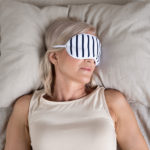By David Blyweiss, M.D., Advanced Natural Wellness
June 8, 2015
- Fear of falling? (More common than you might believe!)
- Simple test reveals your risk
- Dodge this “aging bullet” altogether
When it comes to aging, I’ll bet you have all sorts of concerns. You wonder if your heart is healthy enough to see you into old age, whether you’ll have a stroke or if you’re at risk for Alzheimer’s. So you do everything you can to protect yourself from these very serious health conditions.
But I’ll wager there’s an equally important threat you haven’t thought about yet.
And you may not be taking proactive measures against it.
I’m talking about your risk of taking a tumble due to poor balance as you get older.
This might not sound important to you right now. Especially if you’re feeling hale and hearty. But physical imbalance can reveal itself very quickly. All it takes is that very first fall.
And once that initial tumble happens, getting yourself back into top-notch condition can be a real battle.
Open your arteries, improve blood flow for a new health miracle...
Did you know your circulatory system has over 60,000 miles of arteries, veins and other blood vessels, if stretched end to end?
But as you age, your blood vessels undergo changes, which may cause them to stiffen, thicken and get clogged.
GOOD NEWS! Doctors have now identified a “Miracle Molecule” inside your arteries that helps OPEN your arteries and IMPROVE blood flow.
It’s what Dr. Valentin Fuster calls it, "One of the most important discoveries in the history of cardiovascular medicine."To you, that means...
- Healthy blood pressure
- Sharper mind and memory
- Skyrocketing energy and muscular strength
- Increased pleasure and passion in the bedroom
- Improved circulation to every cell and organ in your body
Go here to discover a new natural way to significantly boost the levels of this miracle molecule in YOUR body NOW!
Now, I’m usually not a fan of “do-it-yourself” tests to see how fit you are. But every now and then, I run across one that makes a lot of sense.
About three years ago, a group of researchers performed some pretty unusual testing.
They had a group of older people try to sit on the floor, and then rise again without using any type of support. And the researchers were able to use the results to assess risk of death over the next several years.
To perform the test, all you have to do is stand up and cross your legs. This means your left foot will be where your right foot should be (and vice-versa) and one foot will be forward a little more than the other.
Next, ease yourself down to the floor into what we used to call an “Indian-style” sitting position when we were kids. Try not to use your hands, knees or arms for support while lowering your body.
Then, rise back up into standing position – also without using support.
If you can do all of this without any support at all, you’ll get a top score of 10 points. However, each time you use a body part for support, you’ll need to subtract a point.
The World's Quickest Solution for Ending Prostate and Urinary Misery
This has recently been revealed to be one of the only real breakthroughs in prostate health.
The seeds of a strange fruit (sometimes called "Chinese Apples") hold powerful phytonutrients that are a revolution in prostate health.
In fact, UCLA and Veterans Administration research have now proved this to be true.
Not only that, but it may be the worlds quickest solution for ending prostate misery.
Simply stated, these phytonutrients represent a huge step beyond beta sitosterol, saw palmetto, and other phytosterols alone.
Simply click HERE if you want to have fast prostate relief...restful, uninterrupted sleep...no more constant "urges to go"...enhanced virility...and optimal prostate support for life.
If you get a score of eight or better, you’re in good shape. Keep doing whatever you’re doing!
But if your score is less than eight, you need work on your balance. And it’s even more critical to improve your balance if your score is less than three.
That’s because this bit of research shows that the lower the score, the greater your risk of death over the next six years.
Part of the reason for this might be due to the risk of hip fractures associated with poor balance. Suffering a fractured hip between the ages of 65 and 84 can triple your risk of death within the first few years.
So, let’s not waste any time. Here’s three stumble-busting exercises to get you started.
Stumble-Buster #1: One-Legged Balance – Power and Stability in Ankles and Knees
Stand with your back about three to four inches from a wall. Leave your arms hanging at your sides, with your palms facing the wall. Lift your right leg with the knee bent at a 45 degree angle. Hold the position for a count of 10. If you find yourself “tilting”, use your fingers to touch the wall and rebalance. Repeat with other leg for a total of five repetitions per leg.
Easy – If your balance is already disrupted, place your hands on a solid table or counter in front of you to keep yourself stable. Then, raise your leg as high as you can with your knee bent – even if it only takes your foot a few inches off the floor – and hold for the same count noted above.
Stumble-Buster #2: One-Sided Airplane – Strength and Flexibility in Hips and Trunk
Get down on your hands and knees, like you would if you were going to crawl. Then, extend your right arm and right leg so that they are parallel to the floor. Next, pull your right elbow down…and the right knee up…so that they touch each other. Return to starting position and repeat 10 times. Then perform the same movements 10 times on your left side. Repeat for a total of five repetitions per side.
Easy – If getting down to the floor is a little tough for you, here’s a simpler version. Seat yourself in a chair with your legs straight out in front of you and your arms raised above your head. Next, pull your right elbow down…and the right knee up…so that they touch each other. Return to starting position and repeat 10 times. Then perform the same movements 10 times on your left side. Repeat for a total of five repetitions per side.
Stumble-Buster #3: Squats – Super Power from Your Trunk to Your Toes
Place your feet hip-width apart with your hands behind your head. Squat at the knees, using your upper thighs and abdomen for strength…and remember to keep your back straight. Count to five, and then rise back up into standing position. Repeat 10 times for a total of five repetitions.
Easy – Perform your squats with your back against the wall or with your hands placed on the back of a stable chair, table or counter. Only squat as far as is comfortable, even if it’s only a few inches.
These exercises don’t take long to perform. And it only takes three to four days each week to establish and maintain balance – and protect yourself from falls in coming years.
Just be sure to check with your doctor before starting any type of exercise program, especially if you’ve been sedentary.
Sources:
Leonardo Barbosa Barreto de Brito, et al. Ability to sit and rise from the floor as a predictor of all-cause mortality. European Journal of Preventive Cardiology. Dec 2012
Richmond J, et al. Mortality risk after hip fracture. J Orthop Trauma. 2003 Jan;17(1):53-6.






